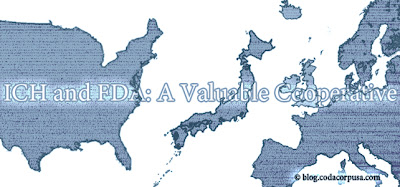In the interest of promoting public health and safety, one of the U. S. Federal Drug Administration’s (FDA) continual goals is to foster the advancement of the global harmonisation of regulatory requirements and practices. The relationship between the FDA and the ICH (International Conference on Harmonisation of Technical Requirements for Registration of Pharmaceuticals for Human Use), is an important component of this initiative.
- United States – FDA, the Pharmaceutical Research and Manufacturers of America (PhRMA), the Center for Drug Evaluation and Research (CDER), Center for Biologics Evaluation and Research (CBER)
- Europe – European Commission, European Federation of Pharmaceutical Industries Associations
- Japan – Japanese Ministry of Health, Labor and Welfare and the Japanese Pharmaceutical Manufacturers Association
- ICH Secretariat (which coordinates the preparation of documentation) – International Federation of Pharmaceutical Manufacturers & Associations (IFPMA)
- ICH Steering Committee – includes representatives from each of the ICH sponsors and Health Canada, the European Free Trade Area (EFTA) and the World Health Organization
- Safety
- Quality
- Efficacy
- MedDRA (Medical Dictionary for Regulatory Activities) – contains highly specific standardized medical terminology
- CTD (Common Technical Document) – describes the common format for the preparation of a well-structured application that will be submitted to regulatory authorities.
- E6 Good Clinical Practice: Consolidated Guideline
- Annex 8 Sterility Test General Chapter
- Q7 A Good Manufacturing Practice Guidance for Active Pharmaceutical Ingredients
- Q8 Pharmaceutical Development
- Q9 Quality Risk Management
- Q10 Pharmaceutical Quality System
The ICH process has achieved significant harmonisation of the technical requirements for the approval of pharmaceuticals for human use in the three ICH regions (EC, U.S., Japan).
While ICH has previously focused on implementing the ICH Guidelines in ICH’s own regions, their currentfocus is to extend the benefits of the collaboration beyond the current ICH regions.
- Globally unifying testing strategies (for applications and other regulatory/compliance needs) (e.g., one test can be conducted rather than three)
- Reducing or eliminating the need to go through a justification procedure (e.g., the process can be completed one time and will eliminate repetitive justifications) by regulators
- Increasing efficiency in developing and registering new products in other countries
- Sharing knowledge globally
- Creating resources that, if utilized, will facilitate safer products from supplier through finished product
- Eliminating duplication in development and registration process
- Streamlining regulatory assessment process for new drug applications
- Reducing the development times and resources for drug development
The FDA made the following statements regarding its involvement with the ICH:
- “ICH was established in 1990 as a joint regulatory/industry project to improve, through harmonisation, the efficiency of the process for developing and registering new medicinal products in Europe, Japan, and the United States without compromising the regulatory obligations of safety and effectiveness.”
- FDA “is committed to seeking scientifically based harmonized technical procedures for pharmaceutical development.”
- FDA has participated in many meetings designed to enhance harmonisation and is committed to seeking scientifically based harmonized technical procedures for pharmaceutical development. One of the goals of harmonisation “is to identify and then reduce differences in technical requirements for medical product development among regulatory agencies.”
Use of CTD – aid in preparing proper format for applications to be submitted
- ESTRI (Electronic Standards for the Transfer of Regulatory Information) – when complete, this will facilitate international electronic communication; a product of this has been eCTD (Electronic Common Technical Document) which allows for the electronic submission of the CTD
- MedDRA – Medical Dictionary for Regulatory Activities Terminology – for all phases of product development; this is available on subscription.
- Free Guidelines to every country, as long as ICH is cited
- One can register for an RSS feed on the ICH website to receive a notice every time a new Guideline is added or modified on the website.
http://edocket.access.gpo.gov/2010/2010-23642.htm – [Federal Register: September 22, 2010 (Volume 75, Number 183)][Notices][Page 57803-57804]From the Federal Register Online via GPO Access [wais.access.gpo.gov][DOCID:fr22se10-92]

 NAVIGATION
NAVIGATION

